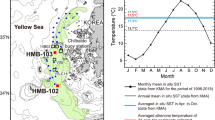Abstract
The spectral characteristics of the δ18O isotopic ratio time series of the Quelccaya ice cap summit core are investigated with the multi taper method (MTM), the singular spectrum analysis (SSA) and the wavelet transform (WT) techniques for the 500 y long 1485–1984 period. The most significant (at the 99.8% level) cycle according to the MTM F-test has a period centered at 14.4 y while the largest variance explaining oscillation according to the SSA technique has a period centered at 12.9 y. The stability over time of these periods is investigated by performing evolutive MTM and SSA on the 500 y long δ18O series with a 100 y wide moving window. It is shown that the cycles with largest amplitude and that the oscillations with largest extracting variance have corresponding periods aggregated around 13.5 y that are very stable over the period between 1485 and 1984. The WT of the same isotopic time series reveals the existence of a main oscillation around 12 y which are also very stable in time. The relation between the isotopic data at Quelccaya and the annual sea surface temperature (SST) field anomalies is then evaluated for the overlapping 1919–1984 period. Significant global correlation and significant coherency at 12.1 y are found between the isotopic series and the annual global sea surface temperature (GSST) series. Moreover, the correlation between the low (over 8 y) frequency component of the isotopic time series and the annual SST field point out significant values in the tropical North Atlantic. This region is characterized by a main SST variability at 12.8 y. The Quelccaya δ18O isotopic ratio series may therefore be considered as a good recorder of the tropical North Atlantic SSTs. This may be explained by the following mechanism: the water vapor amount evaporated by the tropical North Atlantic is function of the SST. So is the water vapor δ18O isotopic ratio. This water vapor is advected during the rainy season by northeast winds and precipitates at the Quelccaya summit with its tropical North Atlantic isotopic signature. It is also suggested from this described stability of the decadal time scale variability observed in the Quelccaya isotopic series, that the decadal time scale GSST variability was also stable during the last five centuries.
Similar content being viewed by others
Author information
Authors and Affiliations
Additional information
Received: 12 February 1997 / Accepted: 9 September 1997
Rights and permissions
About this article
Cite this article
Mélice, J., Roucou, P. Decadal time scale variability recorded in the Quelccaya summit ice core δ18O isotopic ratio series and its relation with the sea surface temperature. Climate Dynamics 14, 117–132 (1998). https://doi.org/10.1007/s003820050213
Issue Date:
DOI: https://doi.org/10.1007/s003820050213




